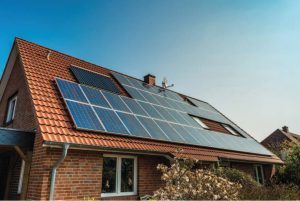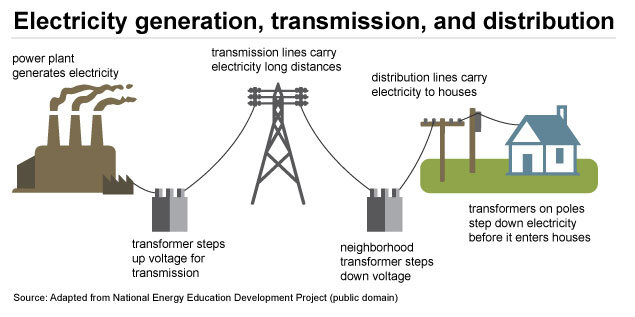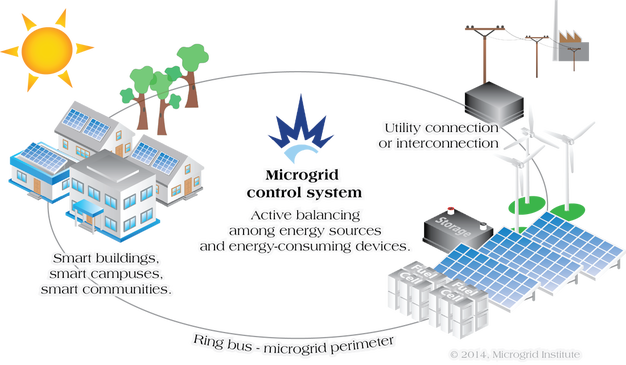Community microgrids are a way for neighbourhoods, villages, towns and cities to meet their energy needs locally. Increasingly, community microgrids are being eyed as an option even in areas where a larger grid already exists, mainly as a way to increase local energy independence and resilience. This article covers community microgrid basics, from the reasons for their growing popularity to their components and applications – as well as an overview of how to join one.
Background: Why community microgrids are a hot topic
In order to understand why microgrids are gaining popularity, it’s helpful to understand how larger electricity grids (‘macrogrids’) operate – and the forces that are currently at play in changing them. The points below detail the changes currently afoot in electrical systems around the world.
The rise of distributed generators in the ‘macro’ grid
A conventional electricity network (AKA ‘the grid’) is essentially comprised of three things:
- energy consumers (homes, businesses, etc);
- the ‘poles and wires’ (the electricity delivery infrastructure); and
- large-scale power plants (e.g. coal, gas, wind, nuclear and hydro).
It is the size of the power plants and the distances that electricity travels (often hundreds or thousands of kilometres) upon which the ‘modern’ grid concept – now over a century old – is based. This has been the model for electricity grids since their creation about 100 years ago.
Diagram overview of how a conventional electricity grid works.
In recent years, however, a fourth component has begun to creep into conventional grids: small-scale distributed generation. Rooftop solar panel systems are the most noteworthy and common example of small-scale distributed generation.
 Affordable small-scale generation is changing our approach to energy
Affordable small-scale generation is changing our approach to energy
The rise of affordable small-scale renewable energy – particularly rooftop solar – is revolutionising energy systems around the world. For the first time, it is possible for virtually any homeowner to affordably meet at least a portion of their energy needs themselves instead of relying wholly on the electricity grid and far-away, large-scale power plants. As battery storage prices come down, households become increasingly able – and likely – to take their energy matters into their own hands.
Energy independence vs sharing with community

This doesn’t mean that we’re headed for an ‘every man for himself’ world of off-gridders hoarding their locally-produced energy like tinned goods in a post-apocalyptic zombie movie. While a good number of people may indeed end up going off the grid in the next decade, the vast majority are likely to remain connected for reasons of convenience, finance or limitations such as lack of roof space for solar panels.
There’s also the fact that each off-grid home will need redundant solar & battery capacity to make it possible for them to live off the grid. This is capacity that will by design sit idle for the vast majority of the time – making off-grid home energy systems larger and much more expensive than grid-connected ones. In the bigger picture of the electricity grid, this would seem to be a waste of resources for society at large, and hints at missed opportunities for the system owner as well.
 Self-interested reasons for staying grid-connected (& sharing your resources)
Self-interested reasons for staying grid-connected (& sharing your resources)
Meanwhile, those who remain connected to the grid with solar & battery storage will see increasing opportunities to participate in the market in ways that benefit them on an individual level – a good example is spot price trading.
The grid will only get smarter as time goes on, dragged into the modern, digital era whether it wants to or not. Those who remain grid-connected will find more ways to save or earn money as utility business models evolve, with the most flexibility for the households that are energy producers as well as consumers.
 System change comes slowly
System change comes slowly
Most electricity grids were at one point in time been government-owned public utilities, which were inherently monopolistic in their nature – they were the only option in the game. Although grids in many places have been privatised to allow for varying degrees of competition and customer choice, the inertia of their history often strongly influences the way that they operate even now – and change comes slowly.
As such, the ‘macrogrid’ is not always a place that is friendly to small-scale distributed generation. As an example, grid-connected solar & battery storage system owners – who not only consume energy from the grid but can also send energy into it – may find themselves being treated as ‘second class citizens’ in an environment that favours simple, straightforward (and more lucrative) ‘consumers’.
Community microgrids as an alternative
For those who dislike the existing system but love this idea of the interactive grid facilitated by existing infrastructure (including the idea of peer to peer energy trading), microgrids offer a middle path. As the name implies, community microgrids are small-scale versions of the grid as we know it, except that they are (ideally) smarter and put more focus on individuals as active participants instead of as passive consumers.
In effect, a community microgrid combines the advantages and resilience of the current grid system with the flexibility individual-centered nature of small-scale, distributed renewable generation – plus all the ‘smart’, digitised communications technology that has become commonplace in our daily lives.
Microgrids at a glance
According to Wikipedia, a microgrid is a ‘localised grouping of electricity sources and loads’ that may or may not be connected to a larger electrical grid. A microgrid could be as small as three houses with solar panels and batteries, or large enough to encompass a whole community, town, city or island with designated generation plants of their own. A good microgrid contains within it many of the redundancies and safeguards that make the modern grid so resilient and reliable, but on a smaller scale.
Microgrids may stand completely on their own as self-contained hubs or may be ’embedded’ inside existing infrastructure, allowing them to draw on mains power in times of short supply or sending/selling electricity back into the greater network/market in times of excess. In most cases, a microgrid will be purpose-built to serve as a microgrid, but in some instances they may be carved out of a pre-existing node on the larger grid.
Example of how a microgrid works. (Image via MicrogridInstitute.org.)
Types of microgrids
Microgrids are built and deployed for a variety of reasons. They can be grouped into roughly five categories.
- Community microgrids (focus of this article) – are microgrids designed to service a designated community. They may or may not have a connection to the main grid. The focus of this type of microgrid is to pool local resources (mainly small-scale renewables) to maximise energy self-reliance. They may also be built or joined for financial reasons – such as high electricity prices on the main grid.
- Campus and institutional microgrids – are for places such as universities and hospitals that need to maintain a power supply in the event that the main grid goes down. The main purpose of this type of microgrid is to maximise usage of on-site generation.
- Remote area microgrids – have no connection to a larger grid, and must be completely self-reliant for their energy needs. The purpose of this type of microgrid is to provide constant, reliable power for the community it serves. Examples include microgrids for remote mining settlements or small to medium-sized islands.
- Military base microgrids – maintain a connection to a main grid but also have enough generation on site to power the community they service for as long as possible in the case of a mains grid outage.
- Commercial & industrial microgrids – are for commercial, manufacturing or data storage facilities for which loss of power supply could be devastating or costly. In these cases, the purpose of the microgrid is usually to maintain supply for at least long enough to power down without damage to the system, but in some cases they may be able to supply power to the system indefinitely.
Components of a microgrid
- Local generation: Any type of generator may have a place on a microgrid, but the ‘fuel free’ nature of renewable energy sources makes them particularly appealing for two main reasons: 1) lessened need to import fuels, and 2) decreased exposure to fuel price fluctuations. Solar PV panels, wind turbines, waste-to-energy, biomass and small-scale hydro power plants may all feed into a microgrid, but diesel generators and cogeneration facilities may also be deployed as backup or to maximise resilience.
- Consumption (AKA ‘load’): There is no point in having power generation if there is no one available to use it. Any type of building or structure that uses electricity is considered a load, and taken into account in the demand-supply energy balance.
- Energy storage: A higher reliance on affordable but ‘intermittent’ renewable energy generators like solar panels and wind turbines lends to various forms of energy storage – with electrical battery storage (e.g. batteries) being the most versatile and (increasingly) affordable. Energy storage will enable the microgrid to store excess energy in times of surplus and release it again in times of need.
- Grid management system: A microgrid taking advantage of modern communications technology will have a ‘smart’ system in place that puts all resources to use in the most cost-effective and efficient way possible. When electricity demand looks ready to outstrip supply, the management system may even ‘shed’ optional loads – remotely and automatically switching off non-essential devices within households and other buildings to prevent a blackout.
- Point of common coupling (PCC): This is the point at which the microgrid connects to the mains grid. A PCC is not a feature in all microgrids, but where it is it offers an extra degree of resilience, as the mains grid can be drawn on as a source of ‘backup ‘power’. Conversely, in the event of a mains grid outage, the microgrid may be able to continue to operate normally.
Joining a community microgrid
If you are interested in joining a community microgrid, you have one of the three options below.
 Finding an existing microgrid to become part of. Unless there is an up-and-running microgrid nearby that is willing to bring you into their fold with a new physical connection to your home, this will require physically moving house. You could start by searching for community microgrids near you, but at this stage there are relatively few available.
Finding an existing microgrid to become part of. Unless there is an up-and-running microgrid nearby that is willing to bring you into their fold with a new physical connection to your home, this will require physically moving house. You could start by searching for community microgrids near you, but at this stage there are relatively few available.- Creating a microgrid out of existing network infrastructure. Depending where you are and what the situation is with your local electricity network company, you may be able to pool resources with your neighbours, community or local government to ‘detach’ from the main grid. Substantial planning would need to go into this approach, and the costs will involve both buying out the existing infrastructure from the entity that owns it as well as ensuring that there is enough energy generation and storage capacity located on your grid node to sustain your community without a connection to the larger grid. Some kind of management system will also be necessary to ensure that all the local resources are put to the best use possible.
- Creating a microgrid from scratch. This is potentially the most capital and planning-intensive option of the the three detailed here, especially if the goal of the microgrid is to take an entire community off the grid. In addition to the considerations in item 2) above, it will also be necessary to build the connection infrastructure itself – the ‘poles and wires’ of the system. This option may be best for communities where each indivdual home is already energy independent on its own right, as building a microgrid would mainly be a matter of ‘connecting the dots’ to tie the collective capacity together.
In summary
Community microgrids are one of the most exciting concepts to have to have emerged in the distributed/renewable energy revolution. They present a unique, appealing, and (possibly) economical option for communities to take their energy matters into their own hands.
This article originally appeared on the carbonTRACK website. Reproduced with permission.
- A guide to community microgrids - 11 July, 2017
- Electricity demand tariffs in Australia – How to handle them - 3 March, 2017

